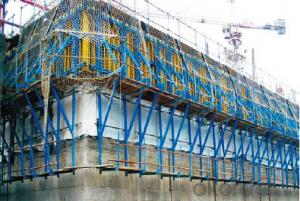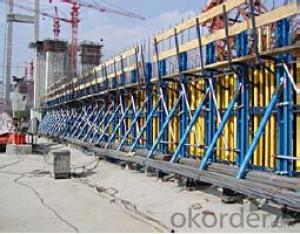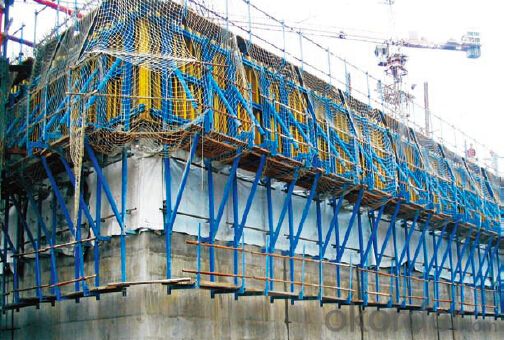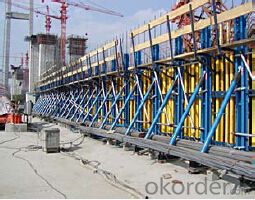Single Side Climbing Bracket for formwork and scaffolding system
- Loading Port:
- Tianjin
- Payment Terms:
- TT OR LC
- Min Order Qty:
- 50 m²
- Supply Capability:
- 1000 m²/month
OKorder Service Pledge
OKorder Financial Service
You Might Also Like
Single-side Climbing Bracket SCB180:
With CNBM SCB 180 climbing systems, the loads from the fresh concrete pressure are
transferred through the brackets by means of V-strongbacks and compression braces into the
scaffold anchors.
Typical applications for the SCB 180 are dams, locks, cooling towers, pier heads, tunnels, and
bank vaults.
The formwork is simply tilted backwards when striking takes place. The 1.80 m wide bracket
requires only a minimum of space.
Characteristics:
◆ Economical and safe anchoring
The M30/D20 climbing cones have been designed especially for single-sided concreting using
SCB180 in dam construction, and to allow the transfer of high tensile and shear forces into the still
fresh, unreinforced concrete. Without wall-through tie-rods, finished concrete is perfect.
◆ Stable and cost-effective for high loads
generous bracket spacings allow large-area formwork units with optimal utilization of the bearing
capacity. This leads to extremely economical solutions.
◆ Simple and flexible planning
With SCB180 single-sided climbing formwork, circular structures can also be concreted without
undergoing any large planning process. Even use on inclined walls is feasible without any special
measures because additional concrete loads or lifting forces can be safely transferred into the
structure.
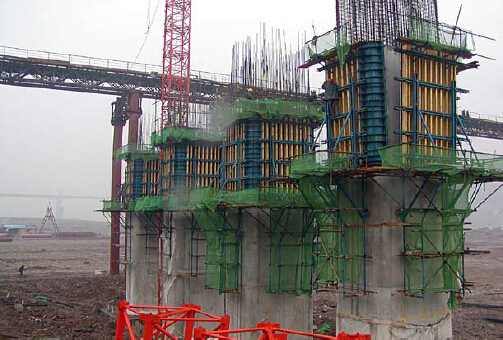
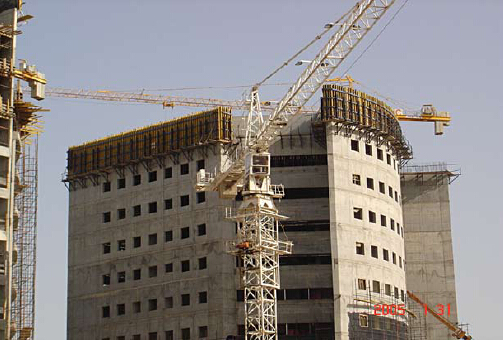
- Q: What are the common design considerations for steel formwork systems?
- There are several common design considerations for steel formwork systems that should be taken into account to ensure the successful construction of a project. Firstly, the load-bearing capacity of the steel formwork system is a crucial consideration. The formwork must be able to safely support the weight of the concrete being poured and any additional loads such as workers or equipment. This requires careful calculation and analysis to determine the appropriate thickness and reinforcement of the steel formwork. Secondly, the formwork system should be designed to provide adequate stability and resistance against lateral forces. This is particularly important in high-rise or complex structures where wind or seismic loads may be significant. The design should incorporate bracing and anchorage systems to ensure the formwork remains stable during construction. Another important consideration is the ease of assembly and disassembly of the steel formwork system. The design should allow for efficient installation and removal, minimizing labor and time requirements. This often involves the use of modular components and standardized connections that can be easily assembled and dismantled. Additionally, the formwork system should be designed to accommodate any necessary adjustments or modifications. Construction projects often require changes or adaptations during the construction process, and the formwork should be flexible enough to accommodate these changes without compromising structural integrity. Furthermore, safety considerations play a vital role in the design of steel formwork systems. The formwork should be designed to provide a safe working environment for construction workers, with features such as handrails, access platforms, and non-slip surfaces. Additionally, the design should consider potential hazards, such as sharp edges or protruding elements, and incorporate appropriate safety measures to mitigate these risks. Lastly, the durability and longevity of the steel formwork system should be taken into account. It should be designed to withstand the harsh conditions of construction, including exposure to weather, chemicals, and repeated use. This may involve the use of corrosion-resistant materials or protective coatings to ensure the longevity and performance of the formwork system. In conclusion, the common design considerations for steel formwork systems include load-bearing capacity, stability against lateral forces, ease of assembly and disassembly, adaptability to changes, safety features, and durability. By carefully considering these factors, engineers can design a steel formwork system that meets the specific requirements of a construction project and ensures its successful execution.
- Q: How does steel formwork accommodate for different concrete curing temperatures?
- Accommodating various concrete curing temperatures is easily achieved with steel formwork, thanks to its versatility and reliability. The standout characteristic of steel formwork is its exceptional thermal conductivity, which effectively dissipates heat from curing concrete. This unique property enables the steel formwork to effectively regulate the concrete's temperature during the curing process. When precise control over the concrete curing temperature is necessary, steel formwork can be equipped with additional features to meet these requirements. For example, insulation materials can be applied to the steel formwork to minimize heat loss or gain, ensuring a consistent and steady curing temperature. This adaptation proves especially beneficial in extreme weather conditions when the ambient temperature can have a significant impact on the curing process. Furthermore, steel formwork can be combined with heating or cooling systems to further regulate the concrete curing temperature. In colder weather conditions, heating elements can be integrated into the steel formwork to maintain an optimal temperature for proper curing. Similarly, in hotter weather conditions, cooling systems can be employed to prevent excessive heat from affecting the curing process. In addition to its temperature control capabilities, steel formwork boasts exceptional strength and durability, making it an ideal choice for accommodating various concrete curing temperatures. The robust nature of steel formwork allows it to withstand the pressure and stresses exerted by the curing concrete, regardless of the temperature. This ensures that the formwork remains intact and stable throughout the curing process, preventing any deformations or failures that could compromise the quality of the concrete structure. Overall, steel formwork offers a comprehensive solution for accommodating different concrete curing temperatures. Its high thermal conductivity, compatibility with insulation materials, and integration with heating or cooling systems make it a versatile option. Additionally, its strength and durability guarantee its ability to withstand the challenges posed by varying curing temperatures, ensuring successful and optimal concrete curing.
- Q: Is steel formwork resistant to corrosion?
- Yes, steel formwork is generally resistant to corrosion. Steel, particularly stainless steel, is known for its high resistance to corrosion, making it a suitable choice for construction applications. However, it is important to note that the extent of corrosion resistance can depend on factors such as the grade of steel used, the environment in which the formwork is used, and the presence of any additional protective coatings. Regular maintenance and proper care can also help prolong the lifespan and corrosion resistance of steel formwork.
- Q: What are the different types of scaffolding used with steel formwork?
- There are several types of scaffolding commonly used with steel formwork, including tube and coupler scaffolding, system scaffolding, and frame scaffolding. Tube and coupler scaffolding consists of steel tubes connected by couplers to form a rigid structure. System scaffolding utilizes pre-engineered components that can be easily assembled, such as modular frames, braces, and platforms. Frame scaffolding involves using vertical frames connected by cross braces and platforms. Each type of scaffolding has its own advantages and is chosen based on factors such as project requirements, ease of assembly, and safety considerations.
- Q: How does steel formwork affect the overall aesthetics of the structure?
- The overall appearance of a structure can be greatly influenced by the use of steel formwork. Its smooth and sleek surface finish gives a clean and contemporary look, which is highly desired in modern architectural designs. The precision and accuracy of steel formwork also allow for the creation of intricate details and complex shapes, enhancing the visual appeal of the structure. In addition, steel formwork allows for the creation of sharp edges and precise lines, resulting in a more refined and sophisticated appearance. This is especially advantageous for structures with exposed concrete surfaces, as the use of steel formwork eliminates the need for additional surface treatments or finishing materials. Furthermore, steel formwork provides versatility in terms of creating different textures and patterns on the concrete surface. Architects and designers can enhance the visual impact of the structure and create unique aesthetic effects by utilizing various surface treatments or coatings, such as acid etching or powder coating. Moreover, steel formwork is known for its durability and structural integrity, ensuring that the aesthetics of the structure remain intact over time. Unlike other types of formwork, steel formwork does not warp or deform, providing a consistent and uniform appearance throughout the construction process and beyond. In conclusion, steel formwork has a positive impact on the overall aesthetics of a structure by providing a sleek and modern finish, allowing for intricate detailing and complex shapes, creating sharp edges and precise lines, offering versatility in texture and pattern, and ensuring long-lasting durability.
- Q: What are the considerations when designing steel formwork for slabs with openings?
- When designing steel formwork for slabs with openings, several important considerations need to be taken into account. These include: 1. Load-bearing capacity: The formwork must be able to support the weight of the concrete, as well as any additional loads that may be placed on it during construction or use. The formwork should be designed to withstand these loads without experiencing excessive deflection or failure. 2. Durability: Steel formwork should be designed to withstand the harsh conditions of construction sites, including exposure to moisture, chemicals, and physical impact. The material chosen should be resistant to corrosion and have a high strength-to-weight ratio. 3. Flexibility and adjustability: Since slabs with openings often have irregular shapes and sizes, the formwork should be designed to be flexible and adjustable. This allows for easy customization and ensures a precise fit for the openings. 4. Support for reinforcement: The formwork should provide adequate support for the reinforcement bars or mesh used within the slab. It should be designed to accommodate the placement and spacing of these reinforcements, ensuring proper concrete cover and structural integrity. 5. Ease of assembly and disassembly: The formwork system should be designed for easy assembly and disassembly, as it needs to be repeatedly used for multiple slabs with openings. The components should be lightweight and easily maneuverable, allowing for efficient construction and reduced labor costs. 6. Safety: Safety is of utmost importance in the design of steel formwork. The formwork should be designed to prevent accidents, such as slipping or collapsing, during assembly, concrete pouring, and removal. Adequate safety measures, such as guardrails and non-slip surfaces, should be incorporated into the design. 7. Cost-effectiveness: The design should aim to minimize material and labor costs while still ensuring the required strength and durability. Efficient use of materials and standardization of components can help reduce overall costs. 8. Compatibility with other construction systems: The formwork should be compatible with other construction systems, such as scaffolding or shoring, to ensure proper integration and coordination during the construction process. By considering these factors, designers can create steel formwork systems that are safe, durable, cost-effective, and efficient for slabs with openings.
- Q: Can steel formwork be used for underwater concrete structures?
- Underwater concrete structures can indeed utilize steel formwork. The durability, strength, and ability to endure harsh environmental conditions are well-known attributes of steel formwork. When employed for underwater concrete structures, steel formwork supplies a dependable and stable framework for pouring and molding the concrete. It can endure the water's pressure and forces, ensuring precise containment and desired shaping of the concrete. Furthermore, steel formwork displays resistance to corrosion, a crucial factor in underwater environments where the probability of rusting is elevated. In summary, due to its strength, durability, and corrosion resistance, steel formwork proves to be an appropriate choice for underwater concrete structures.
- Q: What are the common design considerations for steel formwork in earthquake-prone areas?
- Ensuring the safety and stability of structures in earthquake-prone areas requires careful design considerations for steel formwork. Some key factors to consider for steel formwork in these areas include: 1. Material Strength: It is essential to use steel with high tensile strength to withstand the lateral forces generated during earthquakes. Commonly used high-strength steel grades like Grade 60 or Grade 80 are suitable for earthquake-resistant formwork designs. 2. Reinforcement: Adequate reinforcement of the formwork enhances its rigidity and resistance to seismic forces. Adding steel braces, cross-bracing, or diagonal members can provide additional reinforcement to improve the structural integrity of the formwork system. 3. Connection Details: The connections between different formwork elements should be designed to withstand the dynamic forces induced by earthquakes. Welded or bolted connections are commonly utilized, ensuring they have sufficient strength and ductility to resist seismic loads. 4. Stiffness and Flexibility: The formwork system should strike a balance between stiffness and flexibility. It needs to be rigid enough to withstand lateral forces during earthquakes, while also being flexible enough to absorb and dissipate seismic energy without collapsing. 5. Anchorage Systems: Proper anchorage systems are crucial for securing the formwork to the foundation or supporting structure. These systems should be designed to resist uplift and lateral forces during earthquakes, preventing the formwork from overturning or sliding. 6. Diaphragm Action: To enhance overall structural performance, the formwork system should provide diaphragm action. This means that the formwork acts as a continuous and rigid panel, transferring forces across its surface. This reduces localized stresses and improves the overall stability of the structure during earthquakes. 7. Formwork Compatibility: It is essential to ensure that the steel formwork is compatible with other structural elements, such as concrete columns, beams, and slabs. The formwork system must be able to effectively transfer loads from the concrete to the supporting structure without compromising stability or integrity during seismic events. 8. Construction Practices: In addition to design considerations, proper construction practices are vital for the effectiveness of steel formwork in earthquake-prone areas. Adequate bracing and temporary supports should be used during formwork assembly to maintain stability and prevent collapse before the concrete is poured and hardened. By carefully considering these design factors, engineers and designers can develop robust steel formwork systems that can withstand earthquake forces and ensure the safety of structures in seismic regions.
- Q: How does steel formwork affect the overall construction timeline?
- Steel formwork can significantly impact the overall construction timeline by expediting the process. Its durability and reusability allow for faster assembly and dismantling, reducing the time required for formwork installation and removal. Additionally, steel formwork provides a smoother surface finish, minimizing the need for additional plastering or rendering work, further saving time during the construction phase.
- Q: Can steel formwork be used for both single-use and multi-use applications?
- Steel formwork can be used for both single-use and multi-use applications. The choice between single-use and multi-use largely depends on the specific requirements of the construction project and the budget allocated for formwork. For single-use applications, steel formwork can be easily customized and fabricated to suit the specific dimensions and shapes required for the concrete structure. Once the concrete has set, the formwork can be removed and discarded. This is a cost-effective solution for projects where the formwork will not be required for future use. On the other hand, steel formwork can also be designed and manufactured for multi-use applications. In this case, the formwork is built to be durable and reusable for multiple construction projects. Steel formwork has a longer lifespan compared to other materials such as timber, which makes it suitable for repeated use. Additionally, steel formwork can be easily adjusted and reconfigured to accommodate different shapes and sizes, further enhancing its versatility. However, it is important to note that multi-use steel formwork requires proper maintenance and care to ensure its longevity and structural integrity. Regular inspection, cleaning, and repair of the formwork are essential to prevent any potential issues that may arise from repeated use. In conclusion, steel formwork can be used for both single-use and multi-use applications, depending on the specific requirements and budget of the construction project. While single-use formwork offers a cost-effective solution, multi-use formwork provides durability and versatility for repeated use.
Send your message to us
Single Side Climbing Bracket for formwork and scaffolding system
- Loading Port:
- Tianjin
- Payment Terms:
- TT OR LC
- Min Order Qty:
- 50 m²
- Supply Capability:
- 1000 m²/month
OKorder Service Pledge
OKorder Financial Service
Similar products
Hot products
Hot Searches
